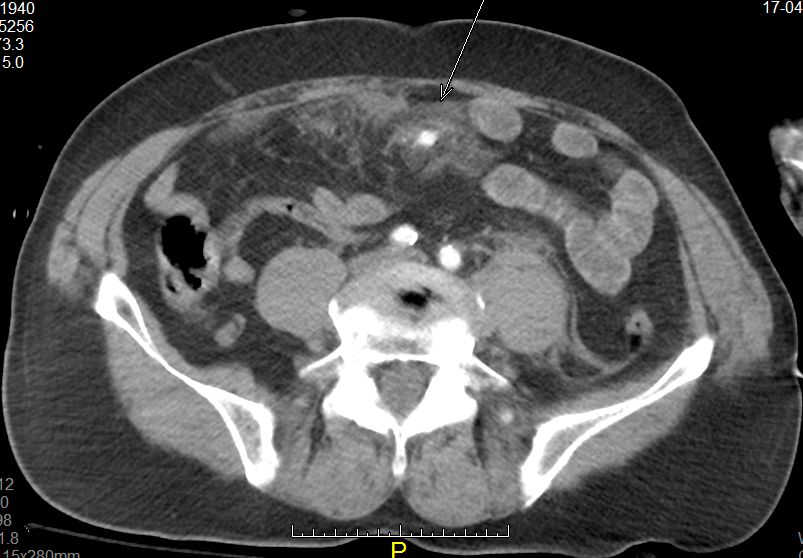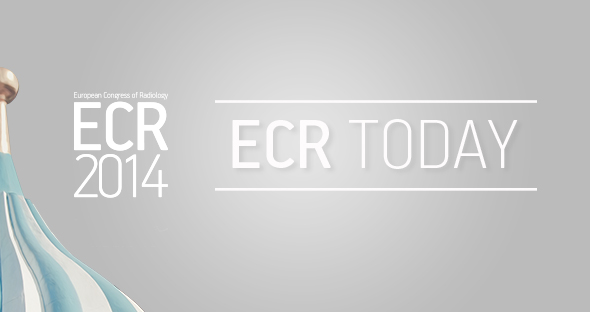American and European emergency radiologists compare experiences
Watch this session on ECR Live: Friday, March 7, room F1
Four separate sessions, starting 08:30, 10:30, 14:00, and 16:00
Tweet #ECR2014F1 #MC422 #MC522 #MC622 #MC722
For the fourth year in a row, the European Society of Radiology (ESR) and the Radiological Society of North America (RSNA) will hold a joint course on a hot topic in radiology. After oncologic imaging for the past three years, emergency radiology will be under the scope of North American and European radiologists, who will share and compare their experiences in the dedicated Mini Course today at the ECR*.

MDCT is the best modality for identifying lesions as subtle as active mesentric bleeding and infiltration
(arrow) caused by blunt abdominal injury (lap-belt compression). (Provided by András Palkó)
Medical emergencies and trauma are responsible for high levels of morbidity and mortality in all age groups worldwide, and trauma is the leading cause of death in people younger than 45. Consequently, the use of imaging in emergency departments has been increasing exponentially since the 1990s. The demand for CT examinations from emergency departments is, for instance, growing annually by 5% to 15%, depending on the institution.
Even with all the advanced tools imaging has to offer, trauma remains a challenge for most emergency services, according to Ulrich Linsenmaier, associate professor of radiology and head of the department of diagnostic and interventional radiology at KMPP Clinics in Munich, Germany. “Even for advanced level 3 medical centres running their own emergency radiology unit, it is a challenge to integrate advanced radiology services into an interdisciplinary team treating patients with acute traumatic and non-traumatic emergencies,” he said.
The session will provide attendees with useful clues on how to make the most of all the imaging modalities and improve cooperation with other physicians. It will also present an overview of common diseases in emergency medicine. “We will talk about what is most likely to happen in the emergency room during day and night in trauma and non-trauma, for instance stroke, acute chest, polytrauma, and acute abdomen. We will deliver strategies on how to identify these patients properly, how to evaluate them and how to image them,” said Linsenmaier, who was recently re-elected as president of the European Society of Emergency Radiology.
Many clinical diagnoses rely on an early and thorough initial radiological diagnostic workup, mostly based on multi-detector CT (MDCT). Radiologists should know the appropriate clinical guidelines and advanced scanning protocols for MDCT, and protocols for conventional radiography and ultrasound. They should also be familiar with logistics and patient management.
Radiology and radiological imaging procedures should be integrated into an interdisciplinary team, recommended Linsenmaier, who also underlined the importance of training. “Emergency radiology is a young subspecialty in Europe, and it is essential for radiologists to get appropriate training to face the demand nowadays,” he said.
North America has long been leading the way in emergency radiology, but Europe has caught up in recent years. It should be very interesting for the audience to have the point of view of both American and European specialists on the topic, according to András Palkó, professor of radiology at Szeged Medical School in Hungary and former president of the ESR.
“The experience on the two sides of the ocean is probably diverging, so comparing and introducing the different attitudes to various topics adds to the information content of such a session greatly,” said Palkó, who will co-moderate the Mini Course with Stuart E. Mirvis, professor of diagnostic radiology at the University of Maryland Medical Center in Baltimore, U.S.
Palkó, a specialist in abdominal imaging, will discuss abdominal injuries, one of the most critical areas of diagnostic imaging, especially in the emergency setting. “The selection of the appropriate imaging algorithm, modality and technique, as well as the precise detection and interpretation of essential imaging findings are frequently challenging, especially because the circumstances under which these examinations are performed, for instance open wounds, bandages, non-removable life-support equipment, lack of patient cooperation, are frequently less than optimal,” he said.
To truly benefit patients, radiologists must have good knowledge of critical imaging signs, symptoms, and the role they play in the evaluation of the patient’s condition. They must also be able to decide fast and work closely with other physicians in the trauma team, Palkó insisted.
*The same course was held at the RSNA meeting in December 2013
Joint Course of the ESR and RSNA: Emergency Radiology
Friday, March 7, 08:30–10:00, Room F1
MC 422: General principles: paediatric and ENT emergencies
Tweet #ECR2014F1 #MC422
Friday, March 7, 10:30–12:00, Room F1
MC 522: CNS emergencies
Tweet #ECR2014F1 #MC522
Friday, March 7, 14:00–15:30, Room F1
MC 622: Chest emergencies
Tweet #ECR2014F1 #MC622
Friday, March 7, 16:00–17:30, Room F1
MC 722: Abdominal emergencies
#ECR2014F1 #MC722



Hi,
Thanks for sharing this information. There are some conferences happening in which medical specialty would be Abdominal Radiology and here is one of those conferences the conference details are given below.
Diagnostic Imaging CME: Penn Radiology CME Organizing 42nd Annual Diagnostic Imaging: Back to the Vineyard held from Jul 06 – 10, 2020 at Edgartown, Massachusetts, USA.
For more information please follow the below link:
https://www.emedevents.com/c/medical-conferences-2020/42nd-annual-diagnostic-imaging-back-to-the-vineyard
Hi,
Thanks for sharing this information. There are some conferences happening in which medical specialty would be Abdominal Radiology and here is one of those conferences the conference details are given below.
The 5th Annual Acute Care and Perioperative Ultrasound Workshop is organized by Loma Linda University (LLU) held from Aug 29 – 30, 2020. The University of California designates this session for a maximum of 17 CME credits.
For more information please follow the below link:
https://www.emedevents.com/c/medical-conferences-2020/2020-acute-care-and-perioperative-ultrasound-workshop